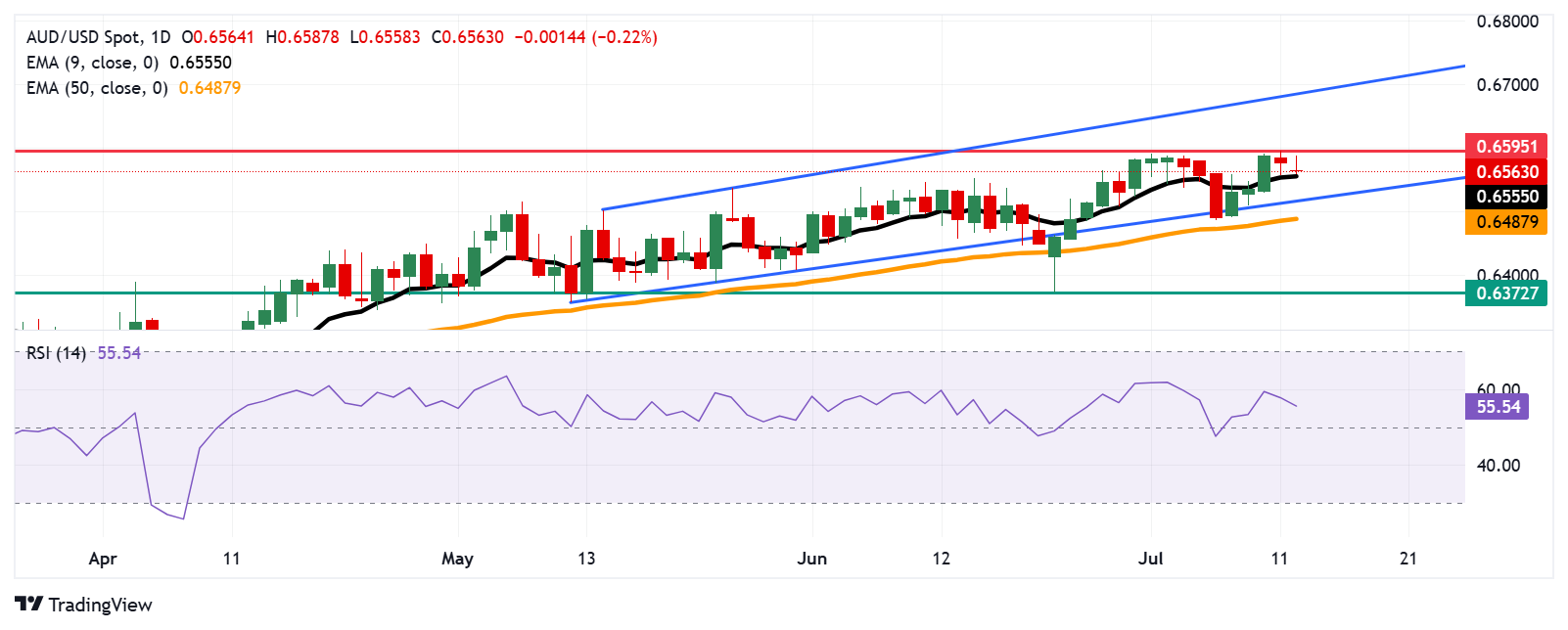- The Australian Dollar remains subdued after China’s trade balance data was released on Monday.
- Australia’s BHP signed a memorandum of understanding with Chinese battery manufacturer CATL.
- Trump announced that a 30% tariff on imports from the European Union and Mexico will take effect on August 1.
The Australian Dollar (AUD) fell against the US Dollar (USD) on Monday, following China’s trade balance data. Additionally, the AUD/USD pair may further lose ground as the US Dollar may regain its ground amid renewed market caution surrounding the Federal Reserve (Fed) policy outlook, driven by the cautious remarks from the Fed’s members.
China’s Trade Balance arrived at CNY585.96 billion for June, narrowing from the previous figure of CNY743.56 billion. Chinese Exports climbs 7.2% year-over-year in June, following 6.3% in April. Meanwhile, imports increased 2.3% YoY in the same period, recovering from a previous decline of 2.1%.
In US Dollar (USD) terms, China’s trade surplus expanded more than expected in June. Trade Balance arrived at +114.77B versus +109B expected and +103.22B prior. Exports rose 5.8% YoY vs. 5% expected and 4.8% prior. Imports increased 1.1% YoY against 1.3% expected and the previous decline of 3.4%.
A Chinese customs spokesperson said that the China’s Exports will continue to forge ahead in the next stage despite challenges. It is important to note that Chinese economic data could impact the AUD, as China is a major trading partner of Australia.
The AUD could have received support as Australian mining and metals company BHP has signed on Monday a memorandum of understanding with Chinese battery manufacturer CATL. The partnership aims to explore collaboration in battery technology for mining equipment and locomotives, including fast-charging infrastructure. Additionally, the two companies will also assess opportunities in energy storage systems and battery recycling solutions for BHP’s mining operations.
The Reserve Bank of Australia (RBA) may maintain the interest rates in August to get inflation on track to sustainably return to the 2-1/2% target. RBA Governor Michele Bullock stated that inflation risks persist, citing the elevated unit labor costs and weak productivity as factors that could drive inflation above current projections. Meanwhile, RBA Deputy Governor Andrew Hauser highlighted growing global economic uncertainty and warned that the impact of tariffs on the world economy could be significant.
Australian Dollar struggles as US Dollar holds ground amid rising trade concerns
- The US Dollar Index (DXY), which measures the value of the US Dollar (USD) against six major currencies, is holding ground around 98.00 at the time of writing. However, the Greenback faced challenges due to escalating global trade tensions.
- US President Donald Trump announced, on Saturday, a 30% tariff on imports from the European Union (EU) and Mexico starting August 1. He also proposed a blanket tariff rate of 15%-20% on other trading partners, an increase from the current 10% baseline rate. In response, the European Union announced on Sunday that it will extend its pause on retaliatory measures against US tariffs until early August, in hopes of reaching a negotiated agreement.
- Chicago Fed President Austan Goolsbee stated that ongoing trade policy at the hands of Trump’s constant tariff threats could hamper the ability of the Fed to deliver rate reductions that both the broader market and Trump himself want to see.
- The US government posted a $27 billion budget surplus in June, fueled by a surge in customs duties revenue, which reached a record $27.2 billion. This jump in tariff collections, largely stemming from policies introduced during the Trump administration, contributed to a 13% increase in total budget receipts, which rose to $526 billion. Meanwhile, federal spending declined by 7% to $499 billion.
- The Federal Open Market Committee (FOMC) Minutes from the June 17–18 meeting, released last week, indicated that policymakers largely maintained a wait-and-see stance regarding future interest rate decisions.
- China’s Consumer Price Index climbed 0.1% year-over-year in June after declining 0.1% in May. The market consensus was 0% in the reported period. Meanwhile, the monthly CPI decreased by 0.1% against the expected 0% reading. Moreover, Producer Price Index (PPI) fell 3.6% YoY in June, following a 3.3% decline in May. The data came in lower than the market consensus of 3.2%. Any change in the Chinese economy could impact the AUD as China and Australia are close trading partners.
- The Reuters survey poll showed that 30 analysts forecasted the Reserve Bank of Australia to cut the cash rate by 25 basis points to 3.60% in August. Australia’s four major banks, ANZ, CBA, NAB, and Westpac, also support the rate cut.
- Australian Treasurer Jim Chalmers said that the Reserve Bank of Australia’s decision to hold rates was neither the outcome millions of Australians had hoped for nor what markets had anticipated. Chalmers added that the central bank has signaled a clear direction on inflation and interest rates moving forward.
Australian Dollar falls toward nine-day EMA near 0.6550
AUD/USD is trading around 0.6560 on Monday. The daily chart’s technical analysis indicated a persistent bullish sentiment as the pair moves upwards within the ascending channel pattern. The 14-day Relative Strength Index (RSI) remains above the 50 mark, strengthening the bullish bias. Additionally, the pair is positioned slightly above the nine-day Exponential Moving Average (EMA), indicating that short-term price momentum is still stronger.
On the upside, the AUD/USD pair could target the fresh eight-month high of 0.6595, which was reached on Friday. A break above this level could strengthen the bullish bias and open the doors for the pair to explore the region around the upper boundary of the ascending channel around 0.6690.
The AUD/USD pair is testing its initial support at the nine-day EMA of 0.6555. A successful breach below this level would weaken the market sentiment and put downward pressure on the pair to test the ascending channel’s lower boundary around 0.6520, followed by the 50-day EMA at 0.6487.
AUD/USD: Daily Chart

Australian Dollar PRICE Today
The table below shows the percentage change of Australian Dollar (AUD) against listed major currencies today. Australian Dollar was the weakest against the Canadian Dollar.
| USD | EUR | GBP | JPY | CAD | AUD | NZD | CHF | |
|---|---|---|---|---|---|---|---|---|
| USD | 0.04% | 0.27% | 0.03% | -0.06% | 0.03% | 0.27% | 0.05% | |
| EUR | -0.04% | 0.20% | -0.02% | -0.12% | -0.03% | 0.23% | -0.01% | |
| GBP | -0.27% | -0.20% | -0.26% | -0.32% | -0.23% | 0.03% | -0.07% | |
| JPY | -0.03% | 0.02% | 0.26% | 0.02% | -0.00% | 0.30% | 0.06% | |
| CAD | 0.06% | 0.12% | 0.32% | -0.02% | 0.08% | 0.35% | 0.11% | |
| AUD | -0.03% | 0.03% | 0.23% | 0.00% | -0.08% | 0.23% | 0.02% | |
| NZD | -0.27% | -0.23% | -0.03% | -0.30% | -0.35% | -0.23% | -0.23% | |
| CHF | -0.05% | 0.00% | 0.07% | -0.06% | -0.11% | -0.02% | 0.23% |
The heat map shows percentage changes of major currencies against each other. The base currency is picked from the left column, while the quote currency is picked from the top row. For example, if you pick the Australian Dollar from the left column and move along the horizontal line to the US Dollar, the percentage change displayed in the box will represent AUD (base)/USD (quote).
Australian Dollar FAQs
One of the most significant factors for the Australian Dollar (AUD) is the level of interest rates set by the Reserve Bank of Australia (RBA). Because Australia is a resource-rich country another key driver is the price of its biggest export, Iron Ore. The health of the Chinese economy, its largest trading partner, is a factor, as well as inflation in Australia, its growth rate and Trade Balance. Market sentiment – whether investors are taking on more risky assets (risk-on) or seeking safe-havens (risk-off) – is also a factor, with risk-on positive for AUD.
The Reserve Bank of Australia (RBA) influences the Australian Dollar (AUD) by setting the level of interest rates that Australian banks can lend to each other. This influences the level of interest rates in the economy as a whole. The main goal of the RBA is to maintain a stable inflation rate of 2-3% by adjusting interest rates up or down. Relatively high interest rates compared to other major central banks support the AUD, and the opposite for relatively low. The RBA can also use quantitative easing and tightening to influence credit conditions, with the former AUD-negative and the latter AUD-positive.
China is Australia’s largest trading partner so the health of the Chinese economy is a major influence on the value of the Australian Dollar (AUD). When the Chinese economy is doing well it purchases more raw materials, goods and services from Australia, lifting demand for the AUD, and pushing up its value. The opposite is the case when the Chinese economy is not growing as fast as expected. Positive or negative surprises in Chinese growth data, therefore, often have a direct impact on the Australian Dollar and its pairs.
Iron Ore is Australia’s largest export, accounting for $118 billion a year according to data from 2021, with China as its primary destination. The price of Iron Ore, therefore, can be a driver of the Australian Dollar. Generally, if the price of Iron Ore rises, AUD also goes up, as aggregate demand for the currency increases. The opposite is the case if the price of Iron Ore falls. Higher Iron Ore prices also tend to result in a greater likelihood of a positive Trade Balance for Australia, which is also positive of the AUD.
The Trade Balance, which is the difference between what a country earns from its exports versus what it pays for its imports, is another factor that can influence the value of the Australian Dollar. If Australia produces highly sought after exports, then its currency will gain in value purely from the surplus demand created from foreign buyers seeking to purchase its exports versus what it spends to purchase imports. Therefore, a positive net Trade Balance strengthens the AUD, with the opposite effect if the Trade Balance is negative.

